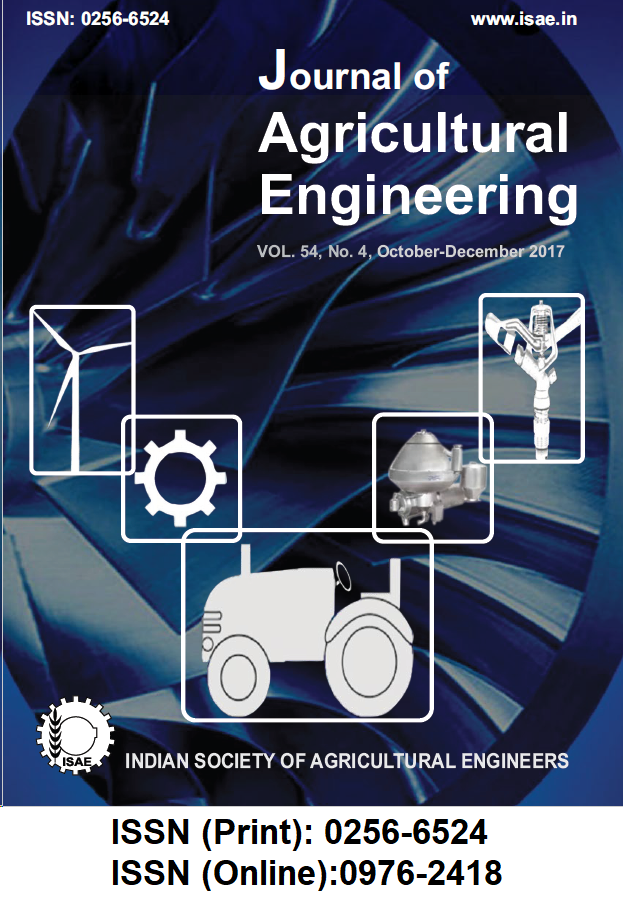Draft Prediction of Commonly Used Tillage Implements for Sandy Clay Loam Soil in India
DOI:
https://doi.org/10.52151/jae2017544.1634Keywords:
Soil bin, draft prediction equation, soil cone index, ASABE model, stepwise regression analysisAbstract
Draft requirements for prototypes of mouldboard plough, cultivator and offset disc harrow with different widths of cut or number of tools were measured at four levels of depth and four levels of forward speed in three soil compaction levels in a soil bin with sandy clay loam soil at an average soil moisture content of 9.58% (d.b.). Effect of depth was more significant on draft of mouldboard plough and offset disc harrow, whereas number of tynes was the most significant factor for cultivator. Rate of increase of draft with respect to depth was higher as compared to forward speed, cone index and width of cut for all implements tested. Draft values predicted by ASABE model were compared with those obtained from soil bin tests at three compaction levels. Quite often, the measured draft values were found to be about 2.9, 1.7 and 1.65 times more than the ASABE predicted values for mouldboard plough, cultivator and offset disk harrow, respectively. An equation similar to the ASABE model incorporating cone index was developed using stepwise regression analyses to model the draft of tillage implements for the range of soil and operating condition tested. Field tests with commercial models of these implements were conducted to acquire data for draft by developing appropriate instrumentation to validate the developed draft equation. The average absolute variations between the predicted and measured values of draft were within 5.5 % and 11.6% for all the implements tested, and thus validated the developed draft prediction equation.
References
Al-Janobi A A; Al-Suhaibani S A. 1998. Draft of primary tillage implements in sandy loam soil. Appl. Eng. Agric., 14(4), 343–348.
ASABE. 2004. Agricultural Machinery Management Data. ASAE D497.4, ASABE Standards, St. Joseph. MI: ASABE, 374-375.
Bloome P D; Batchelder D G; Khalilian A; Riethmuller G P. 1983. Effects of speed on draft of tillage implements in Oklahoma soils. ASAE Paper No. 83-1032, St. Joseph. MI: ASAE.
Clyde A W. 1936. Measurement of forces on soil tillage tools. Agric. Eng., 7, 5-9.
Collins N E; Kemble L J; Williams T H. 1978. Energy requirements for tillage on coastal plains soil. ASAE Paper No. 78-1517, St. Joseph. MI: ASAE, 233-243.
Dransfield P; Willat S T; Willis A H. 1964. Soil to implement reaction angles of attack. J. Agric. Eng. Res., 9(3), 220-224.
Gill W R; Reaves C A; Bailey A C. 1980. The influence of velocity and disk angle on kinematics parameters of disks. Trans. ASAE, 23(6), 1344-1348.
Gill W R; Vanden Berg G F. 1968. Soil Dynamics in Tillage and Traction. Agricultural Handbook No. 316, ARS, USDA, Washington, D. C, 298-339.
Glancey J L; Upadhyaya S K; Chancellor W J; Rumsey J W. 1996. Prediction of implement draft using an instrumented analog tillage tool. Soil Till. Res., 37(1), 47-65.
Grisso R D; Yasin M; Kocher M F. 1996. Tillage implement forces operating in silty clay loam. Trans. ASAE, 39(6), 1977-1982.
Harrigan T M; Rotz C A. 1995. Draft relationships for tillage and seeding equipment. Appl. Eng. Agric., 11(6), 773-783.
Kepner R A; Bainer R; Barger E L. 1978. Principle of Farm Machinery. III Edition, The AVI Publishing Company, Inc. USA, 136-176.
Kydd H D; Frehlich G E; Boyden A R. 1984. Tillage power requirements in Western Canada. ASAE Paper No. 84-1027, St. Joseph. MI: ASAE.
Payne P C J; Tanner D W. 1959. The relationship between rake angle and the performance of simple cultivation implements. J. Agric. Eng. Res., 4(4), 312-325.
Reed I F. 1937. Tests of tillage tools: I-Equipment and procedure for mouldboard ploughs. Agric. Eng., 18, 111-115.
Sahu R K. 2005. Development and performance evaluation of combination tillage implements for 2wd tractors. Unpublished Ph.D. Thesis, Agricultural and Food Engineering Department, IIT, Kharagpur, India.
Serrano J M; Peça J O. 2008. The forward speed effect on draught force required to pull trailed disc harrows. Spanish J. Agric. Res., 6(2), 182-188.
Singh B. 1993. Tractor drawbar performance for secondary tillage. Unpublished M. Tech. Thesis, Agricultural and Food Engineering Department, IIT, Kharagpur, India.
Sohne W. 1956.Some Basic Considerations of Soil Mechanics as Applied to Agricultural Engineering. Transl, 53, National Institute of Agricultural Engineering, Silso, pp.: 11.
Sommer M S; Chen S H; Bierl J F. 1983. Disk blade performance. ASAE Paper No. 83-1537, ASAE, St. Joseph. MI, pp: .
Summers J D; Khalilian A; Batchelder D G. 1986. Draft relationships for primary tillage in Oklahoma soils. Trans. ASAE, 29(1), 37-39.
Upadhyaya S K; Williams T H; Kemble L J; Collins N E. 1984. Energy requirements for chiseling in coastal plane soils. Trans. ASAE, 27(6), 1643-1649.














